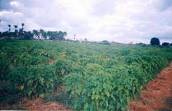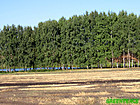|
|
|
|
|
|
|
|
 |
|
|
|
||||
|
|
Model Wasteland Development Work – project EEMWD Apart from forestation work in various part of Tamil Nadu, MCRC undertook a project EEMWD - Ecoengineering and Ethnobotanical Model for Wasteland Development and Design, in 2000 acres. The EID Parry I Ltd. has funded this project and executed in 6 different sites of Tamil Nadu. Initial survey for land identification, raw materials – labour sources, plan of technology implementation, budget and schedule making were done by MCRC. The soil was improved by applying vermiculture technology with native worms and other suitable soil amendments to overcome soil borne problems. Ploughing and mulching of immature weed plants, use of organic compost like NADEP, farmyard manure (FYM) also improved soil fertility, texture and humus content of the soil. The selected tree species seedlings were raised in MCRC’s low cost green house. Then the seedlings are inoculated with compost withVAM (Vesicular Arbescular Mychorrhiza) in the nursery itself and maintained for 6 months to 1 year. Then the healthy seedlings were transplanted to the field. Planting was done in triangular spacing, 15 feet between each plant. Neem were planted in 110 acres, silk cotton in 40 acres and intercrops like indigo, senna were also cultivated. water management, which being part of wasteland development activities special emphasis was given to this. Available water was utilised using well planned water budget and rain water harvesting techniques. Establishment of check dams had a profound effect on ground water recharging. The check dam at Pathamadai farm site has the capacity of 3.5 million L and may be further extented upto 1 billione L capacity of total)Evolution of Agro-Forestry Models The agro forestry project funded by German Development Co-operation, New Delhi, was aimed at the creation of economically viable models with alley cropping of annually or periodically yielding usufruct crops. The tree rows already exist over about 950 acres in ten different localities with a variety of climatic and edaphic conditions. MCRC motivated the local farmers to make use of potential resources for value added commodities from these selected areas. Farmers have taken up alley cropping with pulse and millet crops voluntarily, following the model plots. The project was designed to reduce their dependence on erratic rainfall and gave them harvests from the intercrops, even as the tree rows keep growing to maturity.
|
|
|
|

